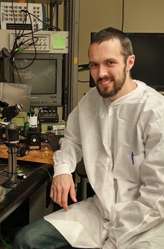Major: Mechanical Engineering
“Evaluate CO2 Sorption Properties of Molecular Sieves with Distinct Pore Sizes and Extra-Framework Cations”

Solvent-based technologies have traditionally been employed to capture CO2 from stationary sources. Yet, such technologies require significant energy for regeneration due to the large amount of water (70% by weight) present in the solution, which is required to minimize corrosion. Solid sorbent materials are being considered as a solvent-free alternative to reduce energy regeneration requirements and CO2 capture costs. To design new sorbent materials that meet such performance goals, we must have a detailed understanding of CO2/sorbent interactions. We have evaluated the CO2 sorption properties of octahedral molecular sieves (OMS) with manganese oxide framework in which the nanopores (prior to contact with CO2) appear to be of comparable size to the kinetic diameter of CO2. Experiments were performed in a high pressure gravimetric instrument and sorption data was corrected for buoyancy. OMS materials were used as model systems with one-dimensional (1D) pore geometry, which offer guest molecules within the 1D pores or tunnels limited degrees of freedom from which CO2 sorption mechanism can be easily drawn. In the spirit of working under a materials-by-design framework, the materials were carefully selected to represent a combination of extra-framework cations that [slowly] span the chemical space offered by the periodic table and test the effect of pore geometries.
How did you find out that you could do research in your field in the summer?
I asked one of my professors at Montgomery College if he knew of any internships that I would be a good match for. He happened to work at the National Institute of Standards and Technology (NIST), and recommended that I apply for the SURF program.
How did you know that research at NIST was what you wanted to do?
Honestly, at the time I applied for SURF, I didn’t know. What I did know is that any chance to work at NIST is a privilege, and an incredible opportunity to gain technical engineering experience and to see if research is a viable career path for me.
Was the application difficult to do? Did you have help with this?
The application is very easy and straightforward. I did not need any help with the application, just make sure you have plenty of time to complete the application and to obtain your letters of recommendation. I would start the application process at least six weeks in advance of the due date.
What was your summer research project?
My project in summer 2014 was characterizing CO2 uptake in a certain class of tunable porous materials. I used gravimetry under high pressure and high temperature to obtain isothermic data on the amount of CO2 adsorbed by these materials. The purpose of these studies is to find new adsorbent materials that will allow for sustainable, energy inexpensive ways to capture carbon from the exhaust streams of large sources of pollution, such as coal power plants.
Who was your mentor for this project?
Dr. Laura Espinal
How much time do you put into this work? Were you paid?
I worked 9-5, Monday through Friday and received a stipend.
What academic background did you have before you started?
In 2006, I received a Bachelor of Applied Arts and Sciences from the University of North Texas. In 2010, I began taking prerequisite classes for an engineering program while working full time. In 2013, I returned to school full-time to pursue a degree in Mechanical Engineering.
How did you learn what you needed to know for this project?
I read scientific papers and books relating to my area of work, as recommended to me by my advisor.
What was the hardest part about your research?
NIST is an intimidating place. It is hard to recognize that, even as an undergraduate, the work that you are providing is important. While you may feel out of place, you have to realize that most investigators look forward to the summer when they have a large group of intelligent, motivated and willing researchers to crank out data!
How does this research relate to your course work?
Especially as I proceed to upper-level engineering courses, I recognize more and more concepts that I was exposed to during my time at NIST. This provides insights into the applications of what we are learning in the classroom.
What is your advice to other students about getting involved in research?
Even if you are not planning a career in research, or even planning on pursuing a graduate degree, gaining experience in scientific research teaches you how to apply knowledge from your coursework in new complex ways. Learning technicianship and critical, application-centered thinking is an invaluable asset to your career advancement. Don’t hesitate to email me or ask any previous SURF students about their experiences.
Are you a transfer student or did you start at UMBC as a freshman? Do you now live on campus or commute to UMBC?
I am a transfer student from Montgomery College and Portland Community College. I commute from Rockville.